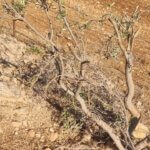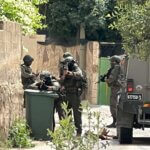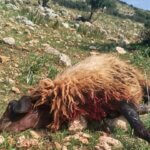When Israel’s bulldozers escape our attention
First published by Electronic Intifada 22nd February 2016
Last autumn, when word came that the unpaved road to al-Hadidiya would be repaired, villagers in this Jordan Valley herding community looked forward to a winter of less hardship.
Now, even when the rains arrived and turned the track into muck, supplies could get through, children could walk to school and the sick could reach clinics.
“I can’t tell you how happy we all were,” said Khadijeh Bsharat, a widow with 11 children, who was interviewed by the Israeli human rights group B’Tselem. “We said to each other that life would be better, and we would be able to get from place to place in summer and winter.”
Residents began working on the road, leveling ruts and spreading gravel over the surface. Although Israeli army officials had issued a stop work order on 15 November, an attorney had won an injunction, and the work, supported by aid from donors, went forward.
Nevertheless, Israeli bulldozers arrived before dawn on 25 November and began to destroy what had been accomplished, piling gravel in heaps.
“The bulldozers began raking up the road,” said Bsharat, “taking our hopes with it.”
Although a member of the Bedouin regional council persuaded the crews to leave after an hour, a full 400 meters had become impassable again.
Now, it seemed to Bsharat, her children could not come to visit her, and sick members of the community would continue to have to ride for help in a tractor or on the back of a donkey.
Routine destruction
To add to the villagers’ dismay, the crews returned the next day to tear down tents, animal shelters, a small silo, a brick oven and even a dovecote, crushing pigeon chicks in the process.
Seven of the demolished structures had been donated by humanitarian groups. Only a small two-person tent remained for a community of nearly 100.
The assault on al-Hadidiya loomed large in the lives of the struggling villagers, but it was a routine affair in the occupied West Bank. The Civil Administration, an Israeli military body that oversees the management of the West Bank, frequently issues demolition orders — for construction work carried out without permits that are rarely tendered, or as punitive measures against those where family members have been deemed a security threat. And demolitions are carried out often seemingly at random.
The United Nations monitoring group OCHA has reported that the Israeli army demolished 447 buildings or structures in Area C of the West Bank in 2015. Area C, a zone designated by the 1993 Oslo accords, covers more than 60 percent of the West Bank and is under full Israeli control.
These structures included the tents and animal shelters of al-Hadidiya.
A further 74 structures were destroyed in East Jerusalem last year.
Israeli law as pretext
This is the face of occupation rarely seen, the attacks on innocents such as the widow Bsharat. No one is accusing these victims of terrorism; Israeli law provides the pretext here.
Israel has designated much land off limits to building in Area C. Where it is allowed, the authorities require building permits, which are almost impossible to get. Palestinians, desperate to provide for their families, thus build without them and hope for the best. Their hopes are often dashed.
OCHA field reports indicate that during 2015, the Israeli army destroyed some 170 housing units in Area C and East Jerusalem, along with shops and other commercial facilities. Israel razed orchards, burned wheat fields and demolished cisterns, wells, an elementary school (donor built), a greenhouse, a plant nursery, workshops, stores, outdoor kitchens, latrines, rest shelters and more.
Sometimes the crews carried away confiscated items: three sheep and an iron gate from the Jabal al-Mukabir neighborhood of East Jerusalem, a number of solar panels, mobile latrines, olive tree saplings, tractors, tools and, in Nablus, four buses (later returned).
Soldiers took a donkey from children in Jenin. They took a forklift from the village of Husan, four water pumps from Khirbet al-Deir in the Jordan Valley and all the plants from a nursery south of Bethlehem.
Each action represented dashed hopes. Families and communities had often worked on a project for months or years only to see it lying in ruins after the bulldozers arrived.
Villagers of Khirbet Yarza spent three years and more than $11,000 building a 1,000 meter fence around their olive groves only to find it demolished under Israeli bulldozers on New Year’s Day 2015.
Israel insists that those handed demolition orders pay the costs of the demolitions. Yet internal OCHA documents that I have seen show that several families chose to demolish their own homes or new additions to their homes in order to avoid the cost of paying for wrecking crews.
A family in Beit Hanina, part of East Jerusalem, destroyed their home of 17 years after losing a battle in the courts. Another family in Jerusalem’s Old City self-demolished a bathroom they had built in 2009.
Deprived of income
Israeli army units tore down tents and simple shelters for animals, they confiscated and destroyed prefab housing units, and they also razed substantial structures. Among them were a three-story commercial building near Qalandiya, originally built in 1971 and renovated in 2013 and a brick factory near Jenin.
Untold stories of loss haunt these reports from the field — the four vegetable stalls razed near Jericho last May, for instance. It took next to no time to destroy these humble structures that provided support for 11 adults and 15 children. Crews also confiscated or damaged 500 boxes of vegetables in the process.
In Jalameh, near Jenin, the demolition men tore up a stand for selling falafel and another used as a taxi call service. A third, selling hot drinks, was confiscated. “All these structures are main sources of income for the families,” an OCHA field report stated.
Many of the buildings and items destroyed were donated by outside agencies, such as the European Union and the International Committee of the Red Cross to compensate for earlier demolitions.
These donors frequently register complaints with Israel. At one point the Red Cross declared that it would no longer provide tents because the army destroyed them as soon as they arrived. But the destruction continues.
The demolitions of 2015 displaced more than 600 people. They also left many animals without shelter.
Overall, in 2015, the military destroyed about 150 animal shelters, affecting thousands of sheep and other livestock. Israel also demolished water tanks, ponds, grazing fields and sheds for storing fodder.
Some animals died as heavy machinery turned shelters into a chaos of falling rubble.
Gaza, of course, was not spared destruction, even if Israeli wrecking crews don’t have the same kind of access there as they do for the West Bank.
In late December, for instance, Israeli aircraft made several sorties to spray herbicides on 421 acres of peas, beans, spinach and parsley in Gaza. The military said it had destroyed the crops to “prevent the use of the area for destructive purposes.”
Driving Palestinians out
In the West Bank, Israel appears determined to drive Palestinians out of Area C. It has made some progress in this endeavor. At one time, residents of Jordan Valley herding communities lived in stone houses; now they are hard pressed to hang onto their donated tents.
The mainstream media are complicit in ignoring this reality and quick to quote Israeli officials when they claim to be making efforts on behalf of the Palestinian economy.
Thus, The New York Times, without a hint of irony, quoted Israeli minister Yuval Steinitz’s comment to reporters last November: “We always agree to confidence-building measures with the Palestinians and to build their economy.”
Barbara Erickson is a journalist living in Berkeley, California. She is a member of Friends of Sabeel-North America and critiques The New York Times coverage of Palestine at her blog, www.TimesWarp.org.







